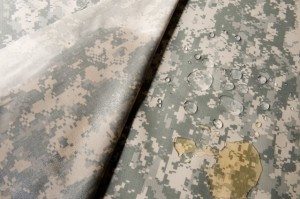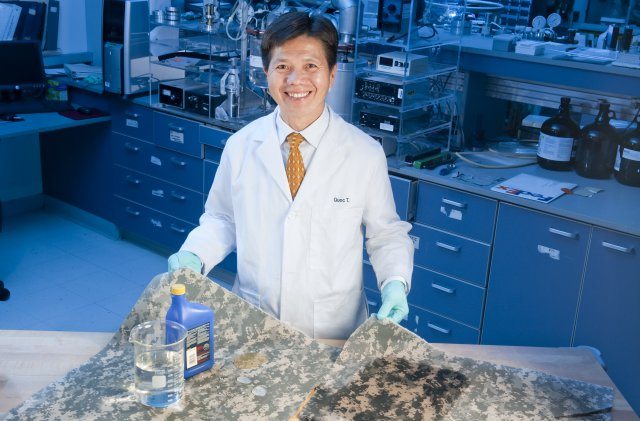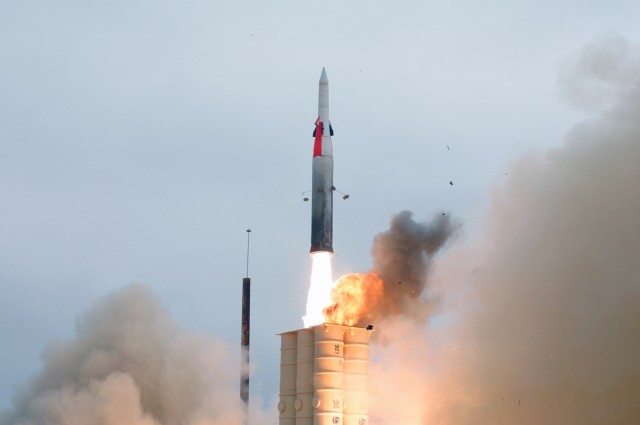Imagine a world without dirty clothes. Quoc Truong, physical scientist at Natick Soldier Research, Development and Engineering Center, wants to make that a reality.
“As a single father of four, I fully understand the rationale for self-cleaning clothing, especially when I look back to the time when my children were younger,” Truong said. “So, when former Army General John Caldwell challenged me to come up with clothing that our Soldiers won’t have to wash, I thought that was a great and stimulating challenge.”
Soldiers cannot avoid getting their uniforms dirty while carrying out their missions, especially on the battlefield. Laundering clothes is time-consuming, adds to the logistics burden on the force, and is not always available to forward-deployed Soldiers, who may come into contact with mud, dirt, water, and an assortment of contaminants such as petroleum, oils, and chemicals.
The fabric Truong helped create has a special durable, super-repellent coating with “dual micro- and nano-size architecture.” When this special coating is applied onto clothing, it will give the surface of the clothing a low critical surface energy, or surface tension. When this surface tension is lower than that of the surface tensions of harmful, toxic liquid chemicals, the toxic chemicals would roll off the fabric on contact. Additionally, fabrics that are coated with this special super-repellent coating showed minimal to no attraction to dust and dirt.
“With minimal or no attractions to dirt and other contaminants, textiles’ frequent launderings will not be necessary, and wash-free clothing could be developed,” Truong said.

“We go one step further to make our self-cleaning clothing with a special surface coating to resist wetting by oil and dangerous chemicals,” said Truong, who wanted to apply these findings to benefit Soldiers.
Truong submitted a Small Business Innovation Research, or SBIR, topic on Development and Applications of superoleophobic coatings for textile applications in 2007 based on earlier work on self-cleaning, but more importantly, it was based on Massachusetts Institute of Technology’s recent breakthrough discovery about designing superoleophobic surfaces.
By leveraging MIT’s technical findings, Truong believed he could develop self-cleaning clothing for Soldiers.
“It took me years to realize that I could address our former Army general’s challenge and make his dream comes true,” Truong said.
The Army accepted the SBIR topic in 2008 to develop self-cleaning clothing based on the use of superoleophobic coatings, which are coatings that do not allow oils, solvents, or chemicals to wet the surface. Since then, Truong has worked with two leading academic and industry partners — MIT and Luna Innovations, Inc.
During the past four years, many tests on omniphobic coated fabrics were produced by MIT. Luna developed the fabrics under Truong’s technical guidance.
Currently, the Army Combat Uniform and Joint Service Lightweight Integrated Suit Technology chemical protective overgarment have a durable water repellent, or DWR, treatment to repel rain. However, this DWR-treated clothing would lose its water repellency after wear, repeated washing, and coming into contact with petroleum, oils, and lubricants.
Performance goals were set to improve the fabric development of self-cleaning clothing.
“In making sure that our self-cleaning clothing does not attract dust, dirt, or get wet, is comfortable and durable to wear, and requires minimal or no laundering to stay clean, we have used many standard tests and also came up with many special non-standard tests and demonstrations,” Truong said. “This is because in certain scenarios such as testing with mud and dirt, there are no test standards out there for us to use.”
Some specific tests that Truong has conducted to create and improve self-cleaning clothing include contact angle measurement, liquid drop roll-off testing, spray testing, abrasion testing, durability testing, and low pressure hydrostatic resistance testing. These tests and others were designed to develop effective, durable omniphobic fabrics.
In 2011 the Luna self-cleaning clothing was produced using a commercial scale coating process, where 25 sets of clothing were subsequently fabricated using a 60-inch-wide omniphobic coated fabric. Twenty self-cleaning garments were field tested in June 2011 for 10 days; Soldiers wore their clothing for up to almost 15 hours each day.
“The results were very promising,” said Truong.
All of the 20 participating Soldiers said their garments shed water well to very well when assessing liquid repellency performance. Sixty-seven percent of the Soldiers said their garments shed oil well to very well. Sixty-nine percent said their Luna omniphobic treated ACU had improved their missions, and 73 percent said their suits should be adopted for use.”
Luna’s omniphobic treated ACU fabric met all of Natick’s performance goals for having high contact angle, moisture vapor permeability, laundering, wash durability, abrasion resistance, tensile strength, air permeability, and flexibility. After the field testing, the omniphobic coating technology was given Air Force Research Laboratory’s only Outstanding Warfighting Transition Award.
NSRDEC is now working with Luna to develop self-cleaning, water and liquid chemical super-shedding clothing that is also multifunctional. A field test of this special multifunctional omniphobic protective clothing will take place in fall 2013.
“In the next few years, you can expect to see self-cleaning clothing that will also be flame resistant and odor free,” Truong said. “These clothes will contain antimicrobial additives, which do not allow microbes to grow on the fabric.
“Someday, we will not have to clean our clothing as often or not at all, and our clothing will remain clean, odor-free, and keep us safe.”
The development, test, evaluation, and limited field demonstration of omniphobic coating technology have shown promise for its potential use as self-cleaning and enhanced chemical-biological protective clothing.











